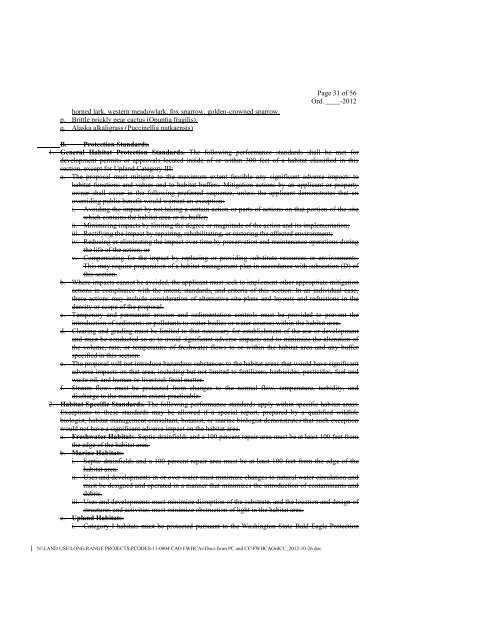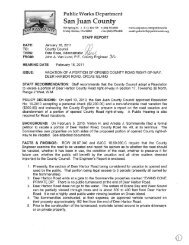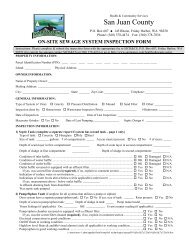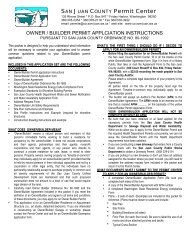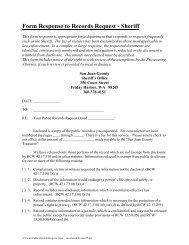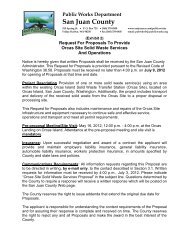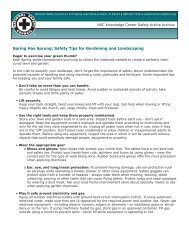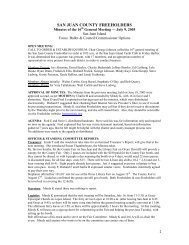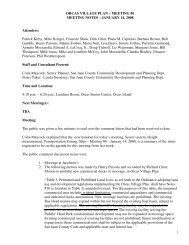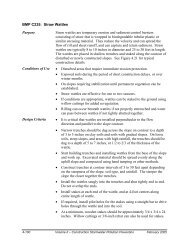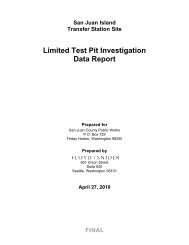Ordinance No._____- 2012 AN ORDINANCE ... - San Juan County
Ordinance No._____- 2012 AN ORDINANCE ... - San Juan County
Ordinance No._____- 2012 AN ORDINANCE ... - San Juan County
Create successful ePaper yourself
Turn your PDF publications into a flip-book with our unique Google optimized e-Paper software.
horned lark, western meadowlark, fox sparrow, golden-crowned sparrow.<br />
p. Brittle prickly pear cactus (Opuntia fragilis).<br />
q. Alaska alkaligrass (Puccinellia nutkaensis)<br />
Page 31 of 56<br />
Ord. ____-<strong>2012</strong><br />
B. Protection Standards.<br />
1. General Habitat Protection Standards. The following performance standards shall be met for<br />
development permits or approvals located inside of or within 300 feet of a habitat classified in this<br />
section, except for Upland Category III:<br />
a. The proposal must mitigate to the maximum extent feasible any significant adverse impacts to<br />
habitat functions and values and to habitat buffers. Mitigation actions by an applicant or property<br />
owner shall occur in the following preferred sequence, unless the applicant demonstrates that an<br />
overriding public benefit would warrant an exception:<br />
i. Avoiding the impact by not taking a certain action or parts of actions on that portion of the site<br />
which contains the habitat area or its buffer;<br />
ii. Minimizing impacts by limiting the degree or magnitude of the action and its implementation;<br />
iii. Rectifying the impact by repairing, rehabilitating, or restoring the affected environment;<br />
iv. Reducing or eliminating the impact over time by preservation and maintenance operations during<br />
the life of the action; or<br />
v. Compensating for the impact by replacing or providing substitute resources or environments.<br />
This may require preparation of a habitat management plan in accordance with subsection (D) of<br />
this section.<br />
b. Where impacts cannot be avoided, the applicant must seek to implement other appropriate mitigation<br />
actions in compliance with the intent, standards, and criteria of this section. In an individual case,<br />
these actions may include consideration of alternative site plans and layouts and reductions in the<br />
density or scope of the proposal.<br />
c. Temporary and permanent erosion and sedimentation controls must be provided to prevent the<br />
introduction of sediments or pollutants to water bodies or water courses within the habitat area.<br />
d. Clearing and grading must be limited to that necessary for establishment of the use or development<br />
and must be conducted so as to avoid significant adverse impacts and to minimize the alteration of<br />
the volume, rate, or temperature of freshwater flows to or within the habitat area and any buffer<br />
specified in this section.<br />
e. The proposal will not introduce hazardous substances to the habitat areas that would have significant<br />
adverse impacts on that area, including but not limited to fertilizers, herbicides, pesticides, fuel and<br />
waste oil, and human or livestock fecal matter.<br />
f. Stream flows must be protected from changes to the normal flow, temperature, turbidity, and<br />
discharge to the maximum extent practicable.<br />
2. Habitat-Specific Standards. The following performance standards apply within specific habitat areas.<br />
Exceptions to these standards may be allowed if a special report, prepared by a qualified wildlife<br />
biologist, habitat management consultant, botanist, or marine biologist demonstrates that such exception<br />
would not have a significant adverse impact on the habitat area.<br />
a. Freshwater Habitats: Septic drainfields and a 100 percent repair area must be at least 100 feet from<br />
the edge of the habitat area.<br />
b. Marine Habitats:<br />
i. Septic drainfields and a 100 percent repair area must be at least 100 feet from the edge of the<br />
habitat area.<br />
ii. Uses and developments in or over water must minimize changes to natural water circulation and<br />
must be designed and operated in a manner that minimizes the introduction of contaminants and<br />
debris.<br />
iii. Uses and developments must minimize disruption of the substrate, and the location and design of<br />
structures and activities must minimize obstruction of light in the habitat area.<br />
c. Upland Habitats:<br />
i. Category I habitats must be protected pursuant to the Washington State Bald Eagle Protection<br />
N:\L<strong>AN</strong>D USE\LONG R<strong>AN</strong>GE PROJECTS\PCODES-11-0004 CAO FWHCAs\Docs from PC and CC\FWHCAOrdCC_<strong>2012</strong>-10-26.doc


